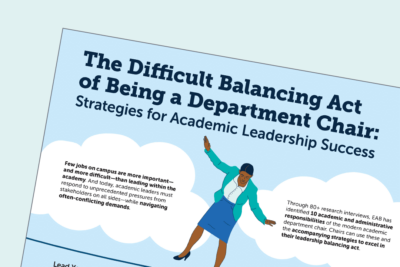4 takeaways for navigating flexible work policies and space utilization in higher ed
Universities are actively implementing return-to-work policies for the upcoming academic year. The COVID-19 pandemic forced students, staff, and faculty to operate in a remote environment, fostering innovation, and establishing new norms.
To learn about the new practices universities are deploying in light of these lessons, EAB gathered chief human resource officers (CHROs) and senior facilities officers (SFOs) from 24 institutions across the United States in two sessions across June 2021.
These conversations were an avenue for leaders to share intelligence on what makes a more flexible work policy effective and how these changes might impact space utilization and employee engagement. Read on to see the takeaways from these conversations.
1. University employees seek flexible work arrangements
Administrative staff were forced to work remotely when the pandemic struck, but many found remote work arrangements more productive and convenient for their lifestyles. Universities on average anticipate a 17% increase in hybrid work arrangements for administrative staff from pre-pandemic levels. However, some universities are limiting flexible work arrangements as campuses resume pre-pandemic operations, leading to negative consequences with both faculty and staff.
One university noted they are actively losing employees to universities with greater work arrangement flexibility. Another university shared two decorated professors took positions at another institution which allowed them to work from home. In short, universities with flexible work arrangements are actively attracting employees from other institutions with stricter in-office requirements.
2. HR leaders are concerned about equity in remote eligibility decisions
From IT to facilities staff, employees increasingly prefer hybrid work arrangements. Institutions shared concerns about decision-eligibility consistency and resulting employee dissatisfaction. Most participating institutions use decentralized approval processes, where decision making rests with managers and unit heads. These institutions anticipate unit-by-unit discrepancies after decisions are finalized, potentially requiring central HR to resolve. Other institutions employ more centralized approval processes to avoid possible inequities, but this model places a heavy administrative burden on HR departments.
To avoid cross-unit blanket decisions, institutions are largely adopting a job-description-based approval model. For example, an IT worker may successfully complete duties like software assistance in a remote environment. Other duties such as replacing a projector bulb require an in-person presence. The employee would be eligible for some remote work based on their responsibilities rather than personal preference. Further, universities are attempting to avoid the perception that hybrid work is more privileged and/or valuable than in-person work. One institution eliminated the labels “essential” and “non-essential” to avoid devaluing certain staff.
Our Remote Work Resource Center will help your institution address the challenges and alleviate the pain points common to remote work.
3. Institutions are reducing square footage, launching hotel desks, and reimagining space
The pandemic showed that an increased hybrid workforce lessened the need for physical space on campus. Several universities let go of leased space to reduce unneeded and costly square footage. Many institutions are also adopting hoteling workspaces for employees in the office part-time. These employees do not have assigned desks and typically reserve space for their in-office days.
One university reduced their facilities office space by 30% by adopting hoteling workspaces. What’s more, cost savings from unrenewed leases and space savings from hoteling create opportunities for alternative space utilization. Universities with more centralized ownership of spaces are particularly well-positioned to reimagine space purposing. For example, universities could use a large lecture hall for a faculty town hall.
Hoteling workspaces: Employees do not have assigned desks and reserve space for their in-office days.
4. Out-of-state employees cause tax, benefit, and compliance challenges
Institutions are developing preferred states for their remote employees to reside. Certain states have more challenging tax and regulatory requirements, making it harder to hire staff residing in those locations. Some universities enacted stringent, high-level approval for out-of-state or out-of-country workers to mitigate the number of requests.
Navigating these challenges requires a lot of work. One institution employs staff in 24 states and expects the number to grow post-pandemic. They had to hire a third-party consultant to navigate tax and benefit compliance challenges, but added it was costly to do so. The participant advised that universities need to justify the return on investment of out-of-state employees with the consultancy fees.
More Resources

The difficult balancing act of being a department chair

4 Misconceptions About Employee Value Propositions that Every Campus Leader Needs to Confront
